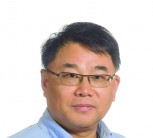South Africa’s national electrical grid system is under increasing strain due to aging infrastructure, insufficient maintenance and a lack of real-time monitoring. Several research groups at UP’s Department of Electrical, Electronic and Computer Engineering (EECE) are working with industry and government to address these challenges by improving energy efficiency and demand side management.
From a world class energy infrastructure in the 1980’s, South Africa’s electrical grid has deteriorated steadily to the state it is in today. Failures in generation, transmission and distribution stem from insufficient maintenance of the grid and the power stations generating power. Eskomis struggling to provide electricity to meet South Africa’s residential and commercial demands despite concerted efforts in Demand Side Management (DSM) over the last 15 years.
Not only is the national grid aging, it is also technologically out of date - modern communications technology holds the potential to provide a wealth of data about the state and functioning of the grid and its various components. Beyond the national electricity system, efficiency in electrical systems could be improved in residential, commercial and industrial sectors by reducing wastage, gathering more data and investigating alternative sources of energy for specific tasks.
The Faculty of Engineering, Built Environment and Information Technology (EBIT) at University of Pretoria houses several research groups that work on various aspects of electrical energy in collaboration with Eskom, the Department of Energy (DoE) and the South African National Energy Development Institute (SANEDI), as well as a number of private companies. These researchers primarily focus on energy efficiency, DSM, integration of renewable energy and smart grids.
The Centre for New Energy Systems (CNES) focuses particularly on efficiency and DSM aspects for the national grid, as well as on improving energy efficiency for various industrial processes and buildings.
The Power group focuses on integrating renewable energy generation such as wind or photovoltaic power into traditional grids, as well as reducing inefficiency and emissions. This is at all levels, from small energy sources like a home photovoltaic (PV) cell to large sources like a wind energy farm.
Together, these groups are helping to make the national grid safer, more stable and more efficient, guiding the integration of sustainable energy sources and improving the data available to engineers working on the grid. Their research is also improving energy efficiency and reducing waste in homes, buildings and factories around South Africa.
Click on the pages below to learn more on how UP partners with government and private sector to boost SA’s electrical grid, what's been plunging SA into the dark, which new innovations at UP are sparking the modernisation of SA's electrical grid, and how CNES at UP is improving energy efficiency.
Click on the video, gallery or infographic in the sidebar to learn how UP's research will help create an energy efficient future or watch Prof Xia explain more in his Expert Lecture.
Improving South Africa’s energy sector is the driving force behind much of the work done at the EECE in the Faculty of Engineering, Built Environment and Information Technology (EBIT) at UP. Many of the projects and research programmes that are currently being pursued by researchers would however not be possible without key collaborations between the School of Engineering and the South African National Energy Development Institute (SANEDI), which is South Africa’s national energy research agency, and other partner organisations.
One of these partners is Eskom with whom the Centre for New Energy Systems, led by Professor Xiaohua Xia, collaborates on several projects and contracts.
“Eskom has been running a very successful Demand Side Management programme for the past 15 years,” he says. “Had Eskom not been doing this, we would have gone straight into stage three load shedding.”
Eskom again comes into play with Professor Ramesh Bansal, who is working on flexible alternating current transmission systems (FACTS) for the power utility. The FACTS systems help to maintain voltage while transporting electrical energy over long distances. As an added benefit, his work on improving renewable and hybrid energy systems are key for South African rural communities, many of which are still without a reliable connection to the national grid.
The Power group under the EECE, led by Professor Raj Naidoo, is working with SANEDI where they have taken a two-pronged approach at boosting the electricity sector. They are developing smart metering technology for municipalities, and developing technical standards for integrating smart grids and devices into the larger network (known as grid codes) and for smart grid data security.
SANEDI, the Department of Energy and the National Energy Regulator of South Africa (NERSA) will implement these technical standards as soon as they get published later this year. With all these efforts, UP’s EECE is directly and indirectly improving SA’s energy sector through its partnerships with government and industry.
South Africa’s national electrical grid system is under increasing strain due to aging infrastructure, insufficient maintenance, and a lack of real-time monitoring. This is a palpable contrast to the world-class electrical grid of the 1980s in South Africa. Professor Xiaohua Xia from the University of Pretoria recently completed a report on the current state of SA’s energy research to look for answers to this problem.
Since the infamous rolling blackouts of 2008, Eskom has taken steps to deal with power shortages across the country using a combination of energy efficiency efforts and Demand Side Management interventions.
According to Prof Xia, who leads the Centre of New Energy Systems (CNES)in the Department of Electrical, Electronic and Computer Engineering (EECE), the cyclical nature of energy demand in South Africa is one of the major energy challenges faced by Eskom.
He says that peak demand in the evenings and in winter can put excessive strain on the national grid, while there is more than enough energy available during downtime. According to Eskom, steps taken to reduce power cuts have saved 4000MW of energy at a very reasonable cost of R3,75 million/MW.
Moreover, municipal energy efficiency interventions like solar water geysers and more efficient streetlights have also had a positive impact. The recently published Section 12L regulations by the National Treasury allow industries to claim a tax allowance of R 0.95 per kWh saved from a baseline amount.
Prof Xia and his group were recently approached by the South African Academy of Science to perform a national benchmarking exercise probing the State of Energy Research in South Africa.
“They wanted an independent look at the status of energy efficiency research in SA,” he says. “We did an overview on the country, where we compared different centres, different topics, and different scientists.”
The group found that insufficient funding is devoted to energy research and there is a lack of coordination in both the research community and government departments.
Despite recent improvements, the country’s national electricity supplier still walks a fine line between supply and demand, which is made more risky by aging and poorly maintained grids and power stations. Improving research and coordination will go a long way to addressing these issues.
The South African electrical grid system has gone from the once world-class energy infrastructure of the 1980’s to a steadily deteriorating and barely maintained service today. UP researchers are addressing this by integrating communication and data collection technologies to provide more information on the state of the grid.
The integration of this new technology affects not only the national electricity system, but can also improve efficiency in residential, commercial and industrial sectors. It does this by collecting important information from sensors in electrical systems that can reduce wastage and help investigate alternative sources of energy for specific tasks and times.
This is where the Power group of the Department of Electrical, Electronic and Computer Engineering (EECE) at the University of Pretoria comes in. Led by Prof Ramesh Bansal, the group is looking at how best to integrate renewable energy sources into conventional power systems using what they call smart grids.
Dr Raj Naidoo, who heads up smart grids research in the Power group, explains the concept using a banking analogy.
“Before internet banking, you would go into a bank and stand in a queue to make a deposit or a withdrawal. You would have to spend a lot of time there and it was very inefficient,” he explains. “Then the internet came along, which allows you to do the same things, but quicker and more efficiently.”
Internet banking revolutionised the banking industry by using the power of the internet to have the many components of banking communicating in a network that ultimately makes it easier for the consumer. In the same way, the old electrical grid can benefit from the connectivity that comes with sensors and smart devices sharing information about the many components of the electrical grid from national to residential level.
By deploying sensor technology, engineers working on an electrical grid can gain extra information about the status of the grid which ultimately improves the efficiency of the system.
This can help to reduce wear and tear, extend the lifetime of the grid, and improve future grid design.
For the household, the smart grid gives information on energy use in the house which can in turn advise on cost saving activities such as incorporating systems like solar water heaters or double glazing on windows.
The data can be used by municipal managers to properly shape pricing for electricity and forecast future power demands to service the community better. Smart grids can maintain productivity for a company in the commercial sector by integrating secondary power sources and prioritising them accordingly.
For industry, smart grid technology can vastly improve the efficiency of various electronic components. For instance, Naidoo’s group has recently developed technology to improve motor efficiencies.
Lastly, the Power group has thought ahead and are working with the South African National Energy Development Institute (SANEDI) and the South African Department of Energy (DoE) to understand and prevent the potential data security threats that might compromise smart grids.
Ultimately, smart grid technology is focussed on collecting more information on how electricity and power is being used, in order to make better management decisions. The Power group is currently building a dedicated smart grids laboratory to do this type of modelling, as part of work with SANEDI and the DoE.
The School of Engineering at the University of Pretoria is home to many important groups dedicated to improving the national electric grid. One such group is the Centre for New Energy Systems (CNES). Headed by Professor Xiaohua Xia, this Centre aims to improve efficiency in the energy sector in South Africa.
To achieve this, CNES hosts a national hub for energy efficiency and demand side management (EEDSM) and conducts research on improving the efficiency of industrial energy systems and buildings. Prof Xia is proud of the Centre’s partnership with the power utility, Eskom, where the Centre is a major provider of measurement and verification services for South African municipalities.
In addition to the above, CNES is also host to the Exxaro Chair in Energy Efficiency (Exxaro is a coal mining company that sponsors research on energy efficiency in the coal mining sector). Through this initiative, the Centre hopes to improve energy efficiency in the industrial sector by developing more efficient technology for mining and factory processes like conveyor belts, and improving the efficiency of pumps and motors.
Another important focus area at the Centre is improving the energy efficiency of buildings through technological developments and the SANS 50010 energy efficiency measurement and verification standards.
“There are a number of building standards globally, but South Africa was the first country to implement a national standard,” says Prof Xia. Other countries have since implemented similar standards for energy efficiency measurement and verification in buildings.
In terms of technology, CNES researchers have developed new water heating systems, improved on existing air-conditioning systems, and even looked at ways to improve overall energy efficiency through lighting, insulation technology and better building design. Researchers at the Centre also work on hybrid energy systems - combinations of different generating technologies which can provide power more efficiently depending on needs of the user.
Prof Xiaohua Xia, Prof Ramesh Bansal, Dr Raj Naidoo, Dr Michael Gitau, Dr Joel Dabrowski, Dr Xianming Ye
August 17, 2017


Professor Raj Naidoo completed his PhD in Electrical Engineering at the University of Cape Town in 2008 and has been doing research at the University of Pretoria (UP) since 2002.
Prof Naidoo leads smart grids research at UP and works closely with other members of the Power Group, which focuses on integrating renewable energy generation such as wind or photovoltaic power into traditional grids, and reducing inefficiency and emissions. This is at all levels, from small energy sources like a home photovoltaic cell to large sources like a wind energy farm.
He says his research allows him to help solve some of the world’s energy problems. “I’m also stimulated in my quest to solve problems and challenge myself in new ways,” Prof Naidoo says. “UP has world-class researchers and infrastructure, and it is a natural alignment for me to do my research at there.”
Some of the practical applications and opportunities for his research include renewable energy integration, energy management and advanced distribution management systems. UP’s Department of Electrical, Electronic and Computer Engineering, which Prof Naidoo heads, works closely with the South African National Energy Development Institute, Rand Water and the Department of Energy. The Department of Electrical, Electronic and Computer Engineering has established strong ties with the local municipality of the City of Tshwane. Together with these partners, Prof Naidoo and his team are paving the way for new approaches to solving Africa’s energy crisis.
His research matters because his department is helping to make the national grid safer, more stable and more efficient, guiding the integration of sustainable energy sources and improving the data available to engineers working on the grid. “Our research is also improving energy efficiency and reducing waste in homes, buildings and factories around South Africa and Africa,” he says. Discussions aimed at collaboration with various faculties are underway.
A recent highlight for Prof Naidoo has been the pioneering of research in smart electrical asset management. “Our research involves the application of smart grid technologies to improve asset management for utilities.”
Prof Naidoo is inspired by Albert Einstein, particularly his ability to derive the theory of relativity from first principles. He also admires Tesla’s work in reshaping various sectors.
Prof Naidoo hopes to create technology that will power sustainable communities in Africa, given that electricity is a challenge for many on the continent.
To school learners or undergraduates who have an interest in solving the world’s energy crisis, he says electrical engineering is for them.
In his spare time, Prof Naidoo enjoys watching and playing football, hiking and being involved in product development.
 Story
Story
University of Pretoria (UP) researchers have found that the antioxidant content of certain types of tea can be likened to that found in recommended portions of fruit and vegetables.
 Infographic
Infographic
Half a cup of black tea, oolong tea or green tea contained the same amount of antioxidants with radical scavenging capabilities (RSC) as that of a 200mg vitamin C tablet.
 Story
Story
The latest issue of the University of Pretoria’s award-winning RE.SEARCH magazine is available now and reflects a shift towards both a fresher design and outlook. This edition is curated under the theme ‘Digital’, and offers a glimpse into some of the fascinating research we’re doing at UP to drive digital leadership and innovation.
Copyright © University of Pretoria 2025. All rights reserved.
Get Social With Us
Download the UP Mobile App